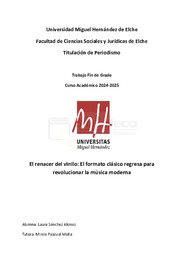Resumen :
El disco de vinilo ha experimentado un notable crecimiento en el panorama musical
contemporáneo, posicionándose como un formato valorado por oyentes de diferentes
generaciones capaz de resistir ante el consumo digital masivo.
En un contexto dominado por las plataformas digitales y la inmediatez, el vinilo representa
una forma de escuchar música más pausada, física y emocional. Su regreso no se debe
únicamente a la nostalgia, sino también a una revalorización del objeto como pieza musical
artística y coleccionable que conecta al oyente con una experiencia mucho más sensorial.
Este fenómeno se ve impulsado por diferentes factores. Por un lado, la implicación de las
discográficas ha sido fundamental, que han apostado por lanzar ediciones en vinilo. Por otro
lado, iniciativas como el Record Store Day, que dan visibilidad a las tiendas de discos
especializadas. Además, existe una comunidad de coleccionistas, DJ’s y melómanos que
valoran la experiencia sensorial que ofrece este formato, que va desde su sonido analógico
hasta el diseño cuidado de las portadas. A este resurgir se le suma la nueva generación de
jóvenes que descubren el vinilo y se interesan por la manera de relacionarse con la música a
través de él.
En conjunto, el regreso del vinilo refleja un movimiento cultural que busca recuperar el valor
de lo físico, el ritual, la espera y la materialidad en la cultura musical actual. Se trata de una
reacción frente al consumo rápido de la música en las plataformas digitales.
Vinyl records have seen a remarkable resurgence in the contemporary music landscape,
becoming a valued format among listeners of different generations and managing to resist
the dominance of digital consumption. In an era driven by streaming platforms and instant
access, vinyl offers a slower, more physical and emotional way of listening to music. Its
return is not solely rooted in nostalgia, but also in a renewed appreciation of the record as
an artistic and collectible object that enhances the sensory experience of music.
This revival has been driven by several key factors. Independent record labels have
embraced vinyl editions as a way to offer added value and uniqueness. Initiatives such as
Record Store Day have also helped energize the market and highlight the role of specialized
record stores, which serve as cultural hubs for music lovers. A vibrant community of
collectors, DJs and audiophiles continues to champion the analog sound, the importance of
album artwork, and the ritualistic nature of playing a record.
Adding to this phenomenon is a new generation of young listeners who are discovering vinyl
for the first time, drawn to its aesthetics, exclusivity, and a listening experience that
demands greater attention and emotional involvement. Altogether, the return of vinyl
records reflects a broader cultural shift, a desire to reconnect with the tangible in response
to the dematerialization of music, restoring the value of physicality, anticipation, and
mindfulness in an increasingly fast-paced and digital music culture.
|
 La licencia se describe como: Atribución-NonComercial-NoDerivada 4.0 Internacional.
La licencia se describe como: Atribución-NonComercial-NoDerivada 4.0 Internacional.
.png)
